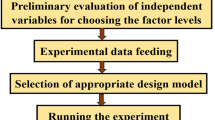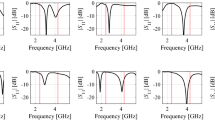Abstract
This paper presents and compares different modifications made to the Complex-RF optimization algorithm with the aim of improving its performance for computationally expensive models with few variables. The modifications reduce the required number of objective function evaluations by creating and using surrogate models (SMs) of the objective function iteratively during the optimization process. The chosen SM type is a second order response surface. The performance of the modified algorithm is demonstrated for both analytical and engineering problems and compared with the performance of a number of existing algorithms. A meta-optimization of the algorithm is also performed to optimize its performance for arbitrary problems. To emphasize the fact that the modified algorithm uses metamodels it is denoted Complex-RFM.




Similar content being viewed by others
References
Andersson J (2001) Multiobjective optimization in engineering design applications to fluid power systems. PhD Thesis, Linköping University, Linköping
Bonnans JF, Gilbert JC, Lemaréchal C, Sagastizábal CA (2006) Numerical optimization: theoretical and practical aspects. Springer, New York
Box M (1965) A new method of constrained optimization and a comparison with other methods. Comput J 8(1):42–52
Duvigneau R, Praveen C (2007) Meta-modeling for robust design and multi-level optimization. In: 42e Colloque dAérodynamique Appliquée, Couplages et Optimisation Multidisciplinaires, INRIA Sophia Antipolis, 19–21 March
Forrester A, Sóbester A, Keane A (2008) Engineering design via surrogate modelling: a practical guide. Wiley, Chichester
Goldberg DE, Holland JH (1988) Genetic algorithms and machine learning. Mach Learn 3(2):95–99
Grefenstette JJ (1986) Optimization of control parameters for genetic algorithms. IEEE Trans Syst Man Cybern 16(1):122–128
Holland JH (1975) Adaptation in natural and artificial systems: an introductory analysis with applications to biology, control, and artificial intelligence. University of Michigan Press, Ann Arbor
Isaaks EH, Srivastava RM (1989) Applied geostatistics. Oxford University Press, New York
Jin R, Chen W, Simpson TW (2001) Comparative studies of metamodelling techniques under multiple modelling criteria. Struct Multidiscip Optim 23(1):1–13
Jin R, Du X, Chen W (2003) The use of metamodeling techniques for optimization under uncertainty. Struct Multidiscip Optim 25(2):99–116
Johansson A, Andersson J, Palmberg JO (2002) Optimal design of the cross-angle for pulsation reduction in variable displacement pumps. In: Power transmission and motion control: PTMC 2002, pp 319–333
Johnson RT, Montgomery DC, Jones B, Fowler JW (2008) Comparing designs for computer simulation experiments. In: Proceedings of the 40th conference on winter simulation, winter simulation conference, pp 463–470
Kitayama S, Arakawa M, Yamazaki K (2011) Sequential approximate optimization using radial basis function network for engineering optimization. Optim Eng 12(4):535–557
Krus P, Ölvander J (2003) Optimizing optimization for design optimization. In: Design engineering technical conferences and computers and information in engineering conference, 2003. ASME Press, New York
Krus P, Ölvander J (2012) Performance index and meta-optimization of a direct search optimization method. Eng Optim 1(ahead-of-print):1–19
Nelder JA, Mead R (1965) A simplex method for function minimization. Comput J 7(4):308–313
Nocedal J, Wright S (2006) Numerical optimization, series in operations research and financial engineering. Springer, New York
Park HS, Dang XP (2010) Structural optimization based on CAD–CAE integration and metamodeling techniques. Comput-Aided Des 42(10):889–902
Redhe M, Forsberg J, Jansson T, Marklund PO, Nilsson L (2002) Using the response surface methodology and the d-optimality criterion in crashworthiness related problems. Struct Multidiscip Optim 24(3):185–194
Reisenthel PH, Lesieutre DJ (2011) A numerical experiment on allocating resources between design of experiment samples and surrogate-based optimization infills. In: 13th AIAA non-deterministic approaches conference
Shan S, Wang GG (2010) Metamodeling for high dimensional simulation-based design problems. J Mech Des 132:051009
Smit SK, Eiben AE (2009) Comparing parameter tuning methods for evolutionary algorithms. In: IEEE congress on evolutionary computation, 2009. CEC’09. IEEE, Piscataway, pp 399–406
Tarkian M, Persson J, Ölvander J, Feng X (2011) Multidisciplinary design optimization of modular industrial robots. In: Proceedings of the ASME 2011 international design engineering technical conferences and computers and information in engineering conference, IDETC/CIE 2011, Washington, DC, USA, 28–31 August 2011, pp 867–876
Wang GG, Shan S (2007) Review of metamodeling techniques in support of engineering design optimization. J Mech Des 129:370
Welch BL (1947) The generalization of ‘student’s’ problem when several different population variances are involved. Biometrika 34(1/2):28–35
Author information
Authors and Affiliations
Corresponding author
Appendices
Annex 1: pseudo code for the Original Model/SM activity of Complex-RFM

Annex 2: pseudo code for the SM check activity of Complex-RFM

Annex 3: coefficients of the Hartmann6 function
See Table 8.
Annex 4: a description of the electric motorcycle model
The electric motorcycle model consists of four major parts—a battery, an electric motor, a gearbox and the motorcycle itself. The parameters of the model can be seen in Table 9.
4.1 The battery model
The voltage of the battery is modeled as a linearly decreasing function of the energy it has delivered, see Eq. 11.
However, the battery can only deliver a certain amount of energy. When the maximum number of Ah is reached, the battery is considered empty and the voltage is set to zero.
4.2 The electric motor
The equations used to model the electric motor are shown in Eq. 12.
A picture of the motor model is shown in Fig.5. The control signal to the motor (C in in Eq. 12) enters the model at the top and is used to reduce the voltage to the motor. The control signal is between −1 and 1 where 1 means full throttle.
4.3 The gearbox
The gearbox has two gears and it is modeled using three parameters, u 1, u 2 and v shift . The gear ratio is changed from u 1 to u 2 at the rotational speed v shift . In the gearbox, the output torque is amplified by a factor u 1 (or u 2) and the torque is then reduced by a factor of 0.95 which models all mechanical losses of the transmission. The model of the gearbox is shown in Fig. 6.
4.4 The motorcycle model
The motorcycle itself is modeled using Newton’s second law, where the input torque is divided by the wheel radius to give the force driving the motorcycle forward. From this force a rolling resistance and the air drag are subtracted, see Eq. 13.
The acceleration a(t) is then integrated to obtain the velocity, which in turn is integrated in order to calculate the distance travelled by the motorcycle, see Fig. 7.
Rights and permissions
About this article
Cite this article
Persson, J.A., Ölvander, J. Optimization of the Complex-RFM optimization algorithm. Optim Eng 16, 27–48 (2015). https://doi.org/10.1007/s11081-014-9247-9
Received:
Accepted:
Published:
Issue Date:
DOI: https://doi.org/10.1007/s11081-014-9247-9







